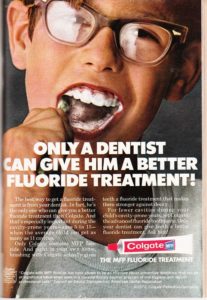Do you remember dental marketing before the digital age when it was made up of TV commercials and print advertising? Back in the latter half of the 20th century, the big dental consumer companies used catch phrases and jingles in their advertisements, some you would probably remember today if you heard them again. The best dental marketing put out by companies like Crest, Polident and Colgate used these tactics to not only promote their products but dental public health in general. Let’s take a walk down memory lane and look at what worked then and how we still incorporate some of these marketing techniques today in dental marketing.
Thanks to the internet, how we reach patients today is more varied and nuanced than ever before. When all we had was a magazine ad or TV commercial, we now use several different ways to reach patients. Not only are the marketing channels different but the language we use has had to keep up with savvy patients, as well. There are, however, some commonalities with how we promote our practices and these old advertisements from larger companies:
It was in the 1950’s that Crest came up with one of the all time memorable slogans in American advertising. Can you guess what it is? Go to the link here to see if you are right: “Look, Mom-no cavities!” was an advertisement campaign that rolled out the first toothpaste to add fluoride. Just as we approach marketing today, Crest didn’t talk about the features of its product but the results. Consumers then and now want to know how the product or service will benefit them. With your own marketing, think about the patient first and what will resonate with them.
 The best dental marketing-then and now-speaks to the pain points of patients. This Polident denture cleaning solution advertisement from the 1940s is a classic example of highlighting a problem and offering a solution. As in this ad, not only did Polident point out the troubles people had with dentures such as keeping them clean and their breath smelling fresh, but it spoke to the heart of the issue-people with dentures wanted their smile to look good. The language we use in marketing now also speaks to the patient’s desire to have a healthy and beautiful smile. In your marketing copy, remember It’s not so much how they get the desired outcome that is important to patients but that there is a solution available to get them there.
The best dental marketing-then and now-speaks to the pain points of patients. This Polident denture cleaning solution advertisement from the 1940s is a classic example of highlighting a problem and offering a solution. As in this ad, not only did Polident point out the troubles people had with dentures such as keeping them clean and their breath smelling fresh, but it spoke to the heart of the issue-people with dentures wanted their smile to look good. The language we use in marketing now also speaks to the patient’s desire to have a healthy and beautiful smile. In your marketing copy, remember It’s not so much how they get the desired outcome that is important to patients but that there is a solution available to get them there.
 In the 1970’s, Colgate not only promoted it’s fluoride enriched toothpaste but the importance of dental health in general using data driven facts. In its advertisement here the ad points out how children are cavity prone and the best way to get a fluoride treatment to avoid tooth decay is through your dentist. In dental marketing today, we use data to help connect patients with information on dental conditions or treatment outcomes, too. It’s not just about having a good looking smile, but the best dental marketing also educates patients on the importance of dental health, too.
In the 1970’s, Colgate not only promoted it’s fluoride enriched toothpaste but the importance of dental health in general using data driven facts. In its advertisement here the ad points out how children are cavity prone and the best way to get a fluoride treatment to avoid tooth decay is through your dentist. In dental marketing today, we use data to help connect patients with information on dental conditions or treatment outcomes, too. It’s not just about having a good looking smile, but the best dental marketing also educates patients on the importance of dental health, too.
While the language and imagery we use has evolved from these old advertisements, some of the basic fundamentals of dental marketing hasn’t changed. Highlighting pain points and benefits to patients will never go out of style.












